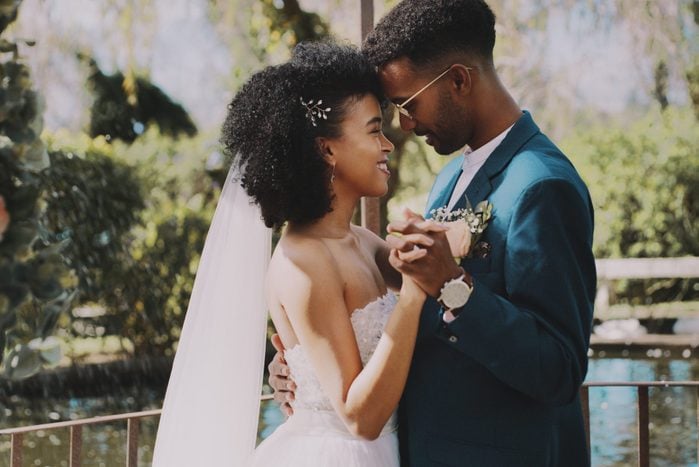
Time-honored wedding traditions
Social media is filled with viral videos of creative and unique wedding ideas, starting with outrageous wedding proposals. And when it comes to asking someone to marry you, all the old wedding traditions are gone, right? After all, 70 percent of modern couples say it’s not the man’s job to propose marriage, and more than 90 percent say a proposal should be discussed first, according to a 2021 survey of 1,200 couples done by wedding-planning site Zola.
Well, it turns out we haven’t ditched all those time-honored wedding traditions. In fact, even though both men and women think it’s fine for either person to propose, 75 percent of women said they wouldn’t do it. From the knee you propose on to how you do the wedding garter belt toss, much of the current wedding etiquette still comes from ancient tradition. We found the sources of these popular traditions and more, including why it’s called the ring finger and the deal with the “something borrowed, something blue” rhyme. Read on to learn the surprising, funny, and even scary stories behind your favorite wedding traditions.
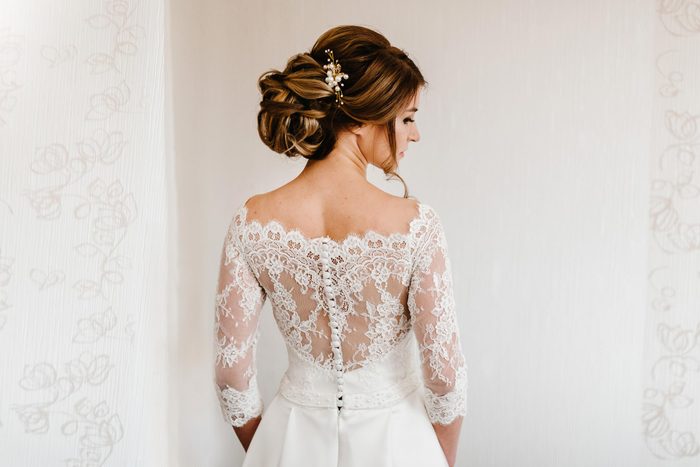
Wearing a white wedding dress
White is by far the most popular color for wedding dresses in the Western world, but that’s a fairly recent tradition. During the royal wedding of Britain’s Queen Victoria and Prince Albert in 1840, Victoria wore a light-colored satin gown. So many brides wanted to look like royalty that they mimicked her dress, including the hue, said to symbolize purity and virginity in Victorian culture.
Fun fact: Although her dress looks white in illustrations from the time, it was actually champagne. Eventually, white became the exclusive color for the bride, and to this day, etiquette dictates that all other guests avoid wearing the shade at a wedding.
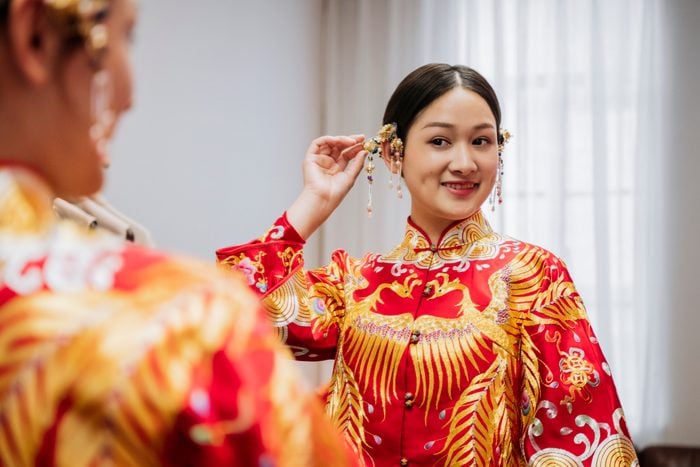
Wearing a red wedding dress
In many Eastern countries, including China, red symbolizes wealth and good fortune, making it the perfect color for brides. The earliest mention of a red-toned wedding dress comes from the Chinese myth of Panhu, a dog-dragon god who became human to marry a princess. As part of the wedding, he made his bride an opulent and brightly colored “phoenix dress.”
Centuries later, many Chinese brides still choose to wear sleek red phoenix dresses. That said, many Eastern brides will have a pre-wedding photo shoot for which they’ll wear a white, Western-style gown. Other cultures have different wedding dress colors, covering the whole rainbow. Attending a wedding? Here’s everything you need to know about wedding guest attire.
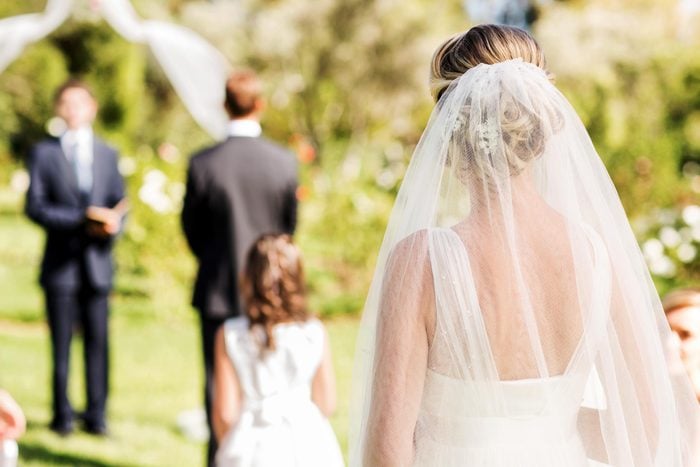
Covering the face or hair with a veil
Queen Victoria chose a long, pale, gauzy veil to go with her iconic wedding dress. It was part of women’s fashion at the time, but her pairing made it into one of the Western wedding traditions we still celebrate today. But Victoria wasn’t the first bride to don a veil.
Many cultures and religions—including Christianity, Judaism, Islam, and Hindu—have used some type of veil during wedding ceremonies for millennia. Ancient Roman brides wore bright yellow veils, said to look like a flame and symbolizing light and warmth. Muslims often veil a bride’s face as a way to show modesty and protect her from evil.
Jewish brides are veiled as a nod to the story of Jacob being tricked into marrying Leah rather than his intended, Rachel—lifting the veil allows the groom to make sure he’s marrying the right person. Speaking of sending a wedding to a screeching halt, here’s what happens if someone objects at a wedding.
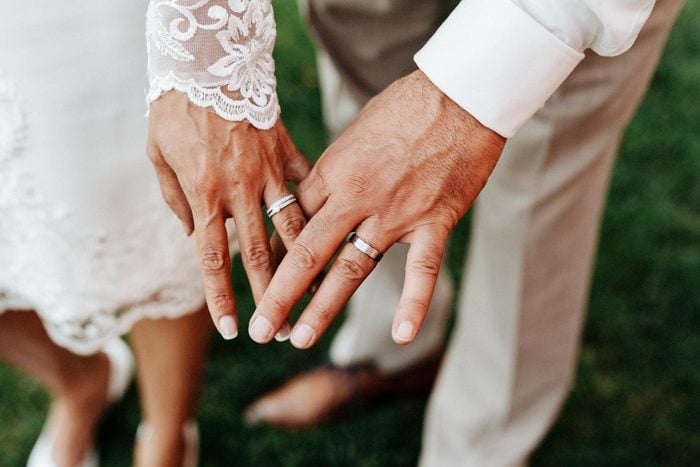
Wearing wedding rings
You can thank the Egyptians for starting the wedding tradition of giving a beloved a ring. The circle of the ring represents eternity, as it has no beginning or end, and the empty space in the center symbolizes a gateway into the unknown. When Alexander the Great conquered the Egyptians, the Greeks adopted this tradition, making their own “love” rings inscribed with Eros and Cupid. The Romans carried on the ring tradition and established gold as the appropriate metal, often adding intricate carvings or gemstones.
From there, wedding rings broadened to include a variety of metals and stones, and the worth depended on the wealth and status of the couple. For a long time, it was just women who wore the ring. It didn’t become common for men to wear a formal wedding ring until around World War I.
If you’re planning a wedding, your shopping won’t stop with the ring. You’ll want to create a registry for your family and friends.
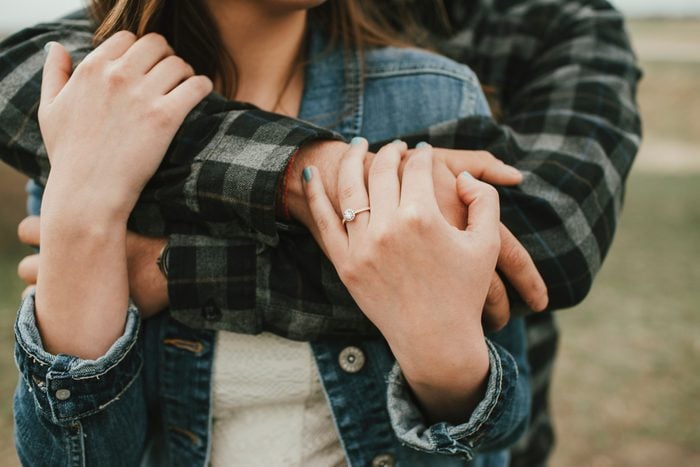
Proposing with a diamond engagement ring
Though the history of wedding rings stretches back to ancient times, the history of engagement rings is somewhat shorter. The practice of having two separate rings—one for the betrothal and the other for the wedding—began in the 12th century.
The Catholic church decreed that a wedding should be a holy ceremony and that a ring for the woman should be part of it. At that point, people started giving one ring as a promise and saving the “real” ring for the ceremony. Now, modern etiquette rules suggest a man should have a ring in his possession if he’s proposing.
Diamonds didn’t become associated with weddings until 1477, when Archduke Maximilian of Austria gave a diamond engagement ring to Mary of Burgundy, the most popular bachelorette of her time. He had it made with small diamonds spelling out her first initial. Diamonds were solidified as the ultimate engagement and wedding ring stone in the 1940s, thanks to a slick marketing campaign by the diamond company De Beers.
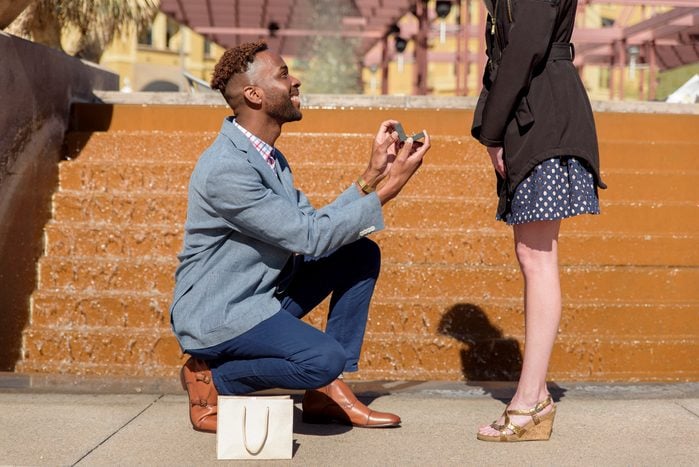
Kneeling to propose
No one is quite sure where the tradition of a man getting down on one knee to propose started. Some say it hearkens back to medieval times, when knights knelt before ladies. Others guess that because it was a sign of surrender during feudal wars that men did it as a symbol of surrendering their will and fortune to their beloved (and to show her family they weren’t a threat). Or it may stem from the Persian tradition of prostrating oneself on the ground to show respect.
But while the roots go back for centuries, kneeling to propose is more of a pop-culture thing, only becoming the standard for Westerners starting in the 1960s. For more wedding fun (or a break from the stress of wedding planning), check out these totally relatable wedding memes.
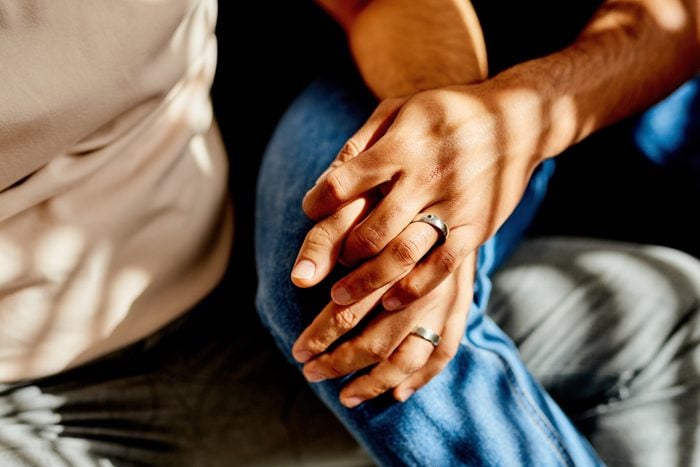
Wearing a wedding ring on the fourth finger
Most married folks today wear their wedding ring on the fourth finger of their left hand, called the “ring finger” for this very reason. You can credit this to the ancient Egyptians as well. They believed the “vena amoris” or “vein of love” ran through the ring finger, directly to the heart. That isn’t anatomically accurate, but it does give beautiful meaning to wearing your ring on that finger.
The Romans adopted this tradition, along with the giving of rings, to show love and commitment. As most people are right-handed, the practice of wearing a wedding ring on the nondominant hand emerged to protect the ring from wear and tear. Once you’re done with these fascinating facts about wedding traditions, check out these funny wedding photos.
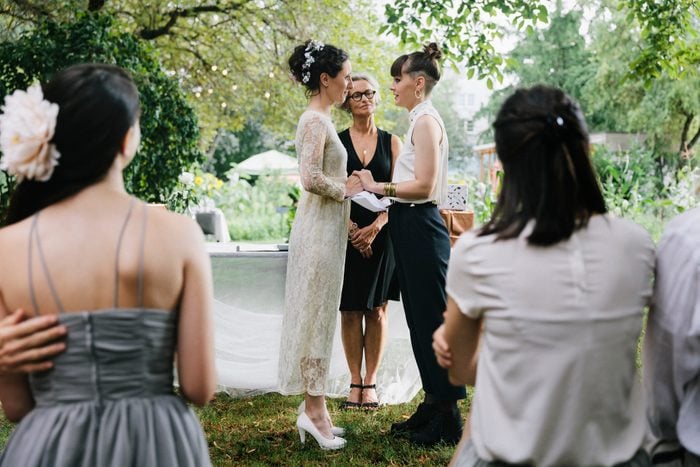
Holding wedding ceremonies
Getting married used to be a much looser affair. In most cultures, it simply required the consent of both parties, usually in the presence of witnesses. In the Middle Ages, English couples showed their consent by accepting an object given to them by their beloved. This object was called a “wed” and was often a ring. The ceremony of joining two people in marriage then got the name “wedding,” a word we still use today.
The Catholic church signed the sacrament of marriage into religious law in the 16th century, and to this day, many people opt to get married in a church (Catholic or otherwise). If you’ll be attending a ceremony this year, pick up one of these wedding gifts for the happy couple.
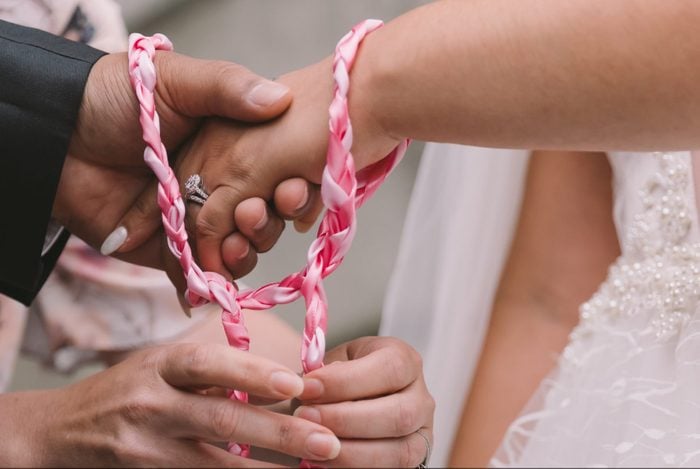
Tying the knot
The phrase “tying the knot” is often used in place of “getting married,” but why? It stems from an ancient Celtic wedding tradition in which the couple’s hands were ceremonially tied together to show unity. A knot was made for each vow, and the couple was given the final knotted rope as a keepsake and reminder of their vows.
Next, learn how to give the perfect wedding toast that will be memorable for everyone.
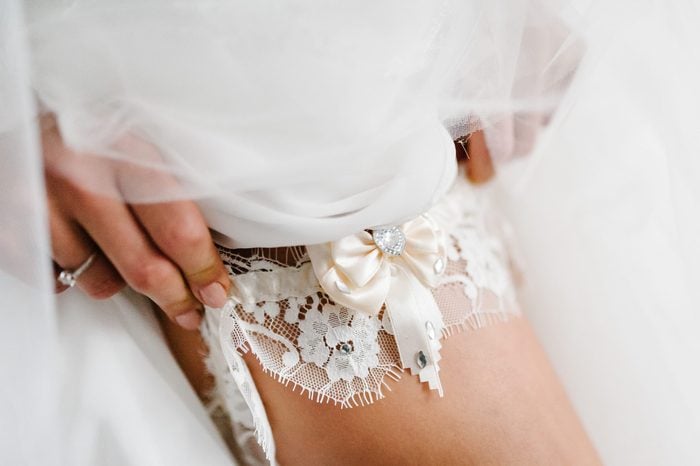
Removing the garter
Slipping off the bride’s garter—a traditional piece of clothing used to hold up stockings before elastic was common—and tossing it to someone single for good luck is one of the oldest recorded wedding traditions. In the Dark Ages, it was considered good luck and “helpful” to the new couple for guests to tear the bride’s clothing off and keep a piece after the wedding. Later, it was also seen as proof that the marriage had been consummated.
Thankfully, the tradition evolved to be less invasive. Now the garter toss is often part of the wedding reception, and a garter is purchased specifically for that purpose, sometimes becoming a family heirloom.
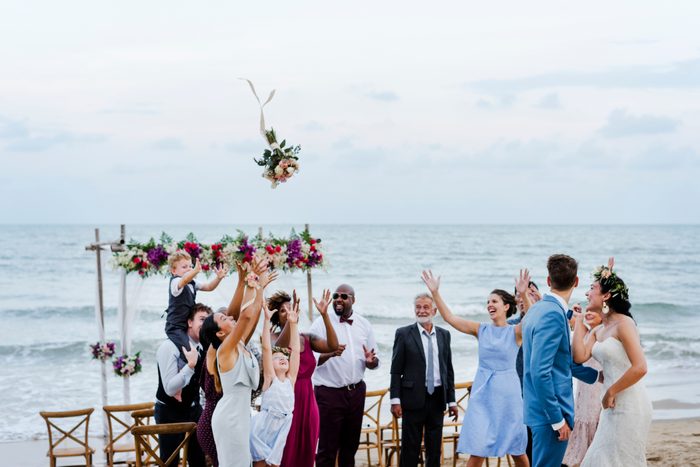
Tossing the bouquet
This tradition—first recorded in England in the 1700s but likely started earlier—also comes from the idea that it was lucky to have a piece of the bride’s clothing. Single women would rush to the bride after the ceremony to touch her and tear off a bit of her dress. To avoid having her dress ruined, the bride would toss the bouquet as a diversion and then run! These days, it’s more about the bride having a fun and special moment with her single friends before embarking on married life.
Getting ready to toss your own bouquet? Wedding planning can be one giant stress event, but these wedding registries make at least one aspect so much easier.
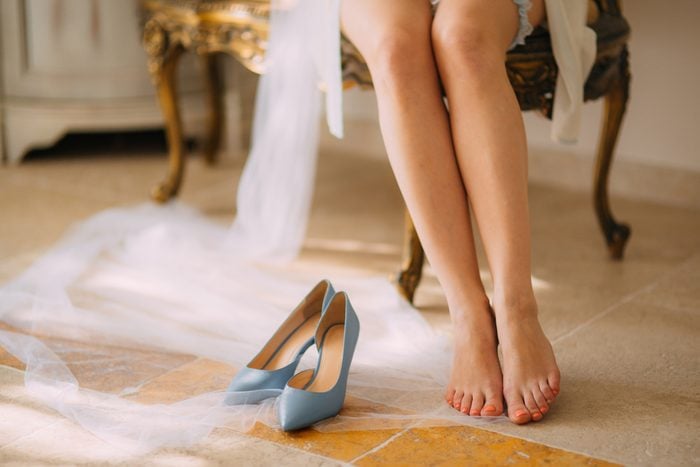
Giving the bride something blue
“Something old, something new, something borrowed, something blue, and a sixpence in your shoe.” The old English rhyme is traditionally used as a guide to what the bride should have before getting married: one item each to remind her of her past, focus her on her future, help her cherish her loved ones, and—
Wait, why the blue? The color is said to represent purity, love, and fidelity and is also meant to ward off the Evil Eye, a curse that could make the bride infertile. The sixpence was an old English coin meant to symbolize financial prosperity for the couple.
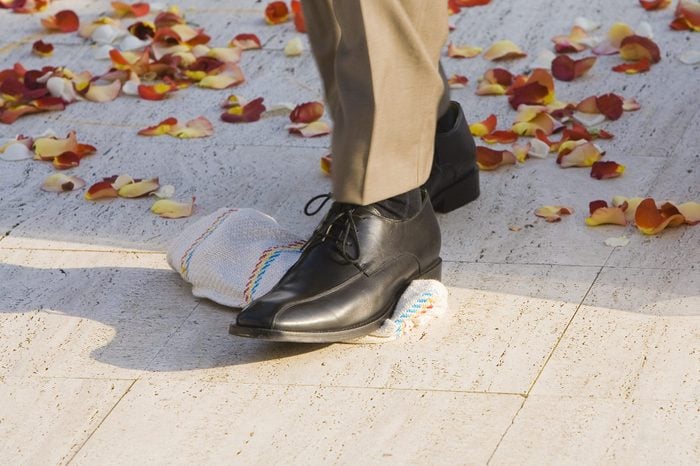
Breaking glass
If you’ve ever been to a Jewish wedding, you’ve seen quite a few wedding traditions: There’s the chuppah, a canopy under which the bride and groom stand. And there’s the recitation of the seven blessings. But if you’ve heard of one tradition (or seen it on film), it’s the shattering of the glass.
To end a Jewish wedding ceremony, the groom (or sometimes the couple) will stomp on a fabric-wrapped glass. The act symbolizes the destruction of the temple in Jerusalem—a solemn reminder of the suffering of the Jewish people. But there are other interpretations of this wedding tradition. According to the book The Jewish Wedding Now, it can also be a reminder of how fragile relationships are and a vow to keep the marriage unbreakable.
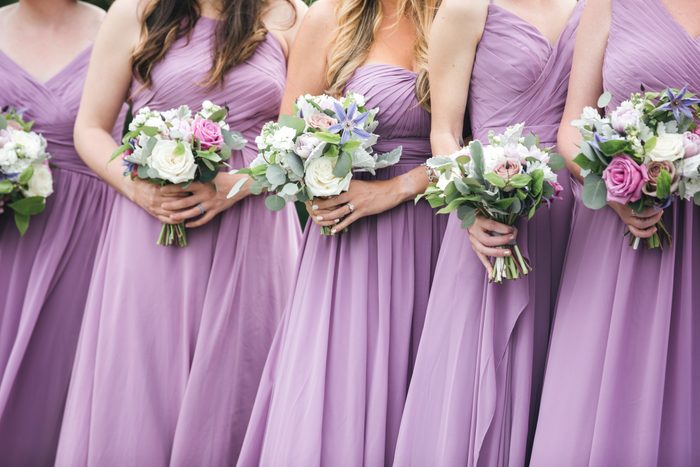
Having bridesmaids and groomsmen
This tradition comes from darker, more violent times, when potential brides were seen as property to be kidnapped, stolen, or even killed by rivals. There are records of people in both ancient Rome and China having an entourage of women in dresses that match the color of the bride to be used as decoys.
Similarly, groomsmen were the groom’s bodyguards. (The “best man” was usually the best sword fighter!) Romans formalized the tradition, making it a law that a couple had to have at least 10 witnesses wearing matching colors to certify the marriage. Queen Victoria again set the modern trend when she had 12 bridesmaids wearing matching white gowns.
Also among the wedding traditions that stood the test of time: the speeches given by the best man and maid of honor. If you’re filling that role for a bride or groom this year, save some of these wedding jokes and quotes for your speech.
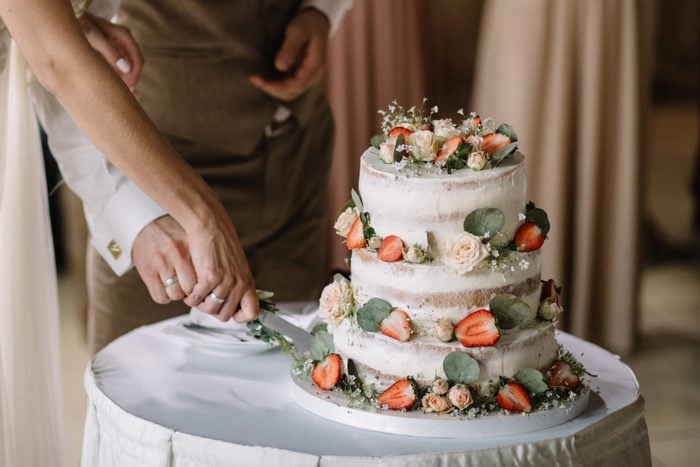
Serving a wedding cake
What’s a wedding without a grand confection as the centerpiece? Serving wedding food may have begun with the Roman tradition of crumbling a wheat biscuit over the bride’s head to symbolize fertility. The traditional wedding cake also had a strange beginning. For starters, it used to be a pie, and it contained oysters, lamb testicles, sweetbreads, rooster comb, and pine kernels, according to a 1685 recipe.
But tasty food and celebrations have always gone together, and each culture has developed special wedding foods. In the West, it’s usually a layered, frosted cake. The French often serve croquembouche, a tower of filled cream puffs. The Chinese have “marry girl cake,” a sponge cake made with duck egg, lotus seed, or yellow-green bean paste. Korean brides serve tteok, a colorful rice cake. And in Slavic weddings, the cake takes a backseat to the korovai, a multilayered bread with intricate designs that’s displayed prominently at the church and served at the wedding.
Sources:
- Jstor Daily: “A Natural History of the Wedding Dress”
- Brides: “Everything You Need to Know About the Wedding Veil Tradition”
- GIA: “The Origin of Wedding Rings: Ancient Tradition or Marketing Invention”
- The Garter Girl: “Wedding Garter History”
- Brides: “Everything You Need to Know About Proposing on One Knee”
- Culture Trip: “Where Does the Phrase ‘Tie the Knot’ Come From?”
- Ecpi University: “Wedding Cakes from Around the World”
